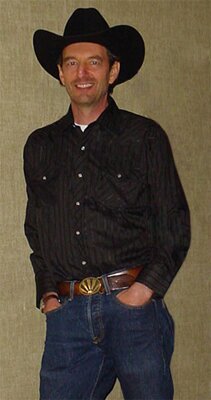Welcome to the “My Place” page
 My name is Scott My name is Scott
I run the Rope and Wire website.
My original idea for this page was to give those living in the country the opportunity to tell others about the things that made their farm or ranch so special.
Well, I’ve come to the conclusion that either no one likes to brag or no one lives on a farm or a ranch. Whatever the case, no one submitted an article so I felt it was high time to try something different.
So for now this will be literally “My Place.” I’ll use this page to post a western blog or short articles. They will either be mine, or possibly one from a contributing R&W community member.
The theme will remain Western but the content will change weekly, or there about.
If you click on any of the links to past blog's, you can return to this page by clicking on the My Place button across from my picture.
I hope you enjoy it but if not, might I suggest you “stroll the grounds.” Read a story or watch a movie.
Thanks for visiting.
Scott
Duck Fight
by Mike Cox
It started over a duck.
Caleb Berg (Cape) Willingham, first sheriff of newly-organized Oldham County, was in the Equity Bar, Tascosa’s oldest saloon, when he heard a commotion outside. Suddenly one of the town’s few ladies did something most ladies of the era would not she ran into the drinking establishment.
“He killed my duck!” she yelled, pointing to a man outside. “Shot it just now.”
Willingham saw that the woman was referring to Fred Leigh, foreman on the LS Ranch. Leigh was known for his drinking and had been warned before about carrying a pistol in town.
“He did, did he?” the sheriff asked. “Well, now, don’t you worry. I’ll see that the gentleman pays you for your duck.”
Armed with a double-barreled shotgun, the big sheriff walked out and approached the cowboy to discuss the fair market value of domesticated migratory waterfowl.
“You’re in debt to this woman for that duck you shot just now,” the sheriff said. “You going to pay for it?”
“Hell, no, I ain’t going to pay for no duck,” the cowboy replied.
Willingham was in the process of reminding the cowboy that he was sheriff when he saw the drover’s hand moving toward the six-shooter on his hip. That ended the talking. The sheriff let loose with both barrels of his scattergun. With 18 pieces of buckshot in his body, the cowboy tumbled from his horse, as dead as the duck he’d blasted a short time before.
Not only had Leigh been killed on account of a duck, he had the added distinction of being the first person buried on a hill outside Tascosa that soon bore one of the most famous names in the Old West. Leigh having died with his boots on, saloon proprietor Jack Ryan thought it fitting that the new graveyard be called Boothill. (Dodge City also had a Boothill, but that was way off in Kansas.)
Willingham went on to serve out his term as sheriff, but in 1882 he was defeated in his bid for another two years in office. After losing the election, Willingham moved east across the Panhandle to Wheeler County, where he operated a saloon in Mobeetie. Later, he became manager of the Turkey Track Ranch.
Without mentioning his sources, J. Marvin Hunter described Leigh’s death in an article he wrote for his Frontier Times Magazine in 1943. Three years later, Amarillo writer John McCarthy told the story a little differently in his book “Maverick Town: The Story of Old Tascosa.”
In McCarthy’s version, the woman who owned the duck was pregnant. She fainted after seeing Leigh shoot off the bird’s head. McCarthy also listed Leigh as the second occupant of Boothill, not the first. But both authors agreed that it all started over a duck.
Hunter said the shooting happened in 1879, but Willingham had not become sheriff until 1880. McCarthy did not offer a date in his book.
No matter exactly when Leigh died, or whether he was permanent guest No. 1 or No. 2, Boothill cemetery went on to accommodate a total of 32 graves. Twenty-three of the occupants were men who, like Leigh, died with their boots on.
Tascosa, like most of the people in its cemetery, did not live to enjoy old age. When the Fort Worth and Denver Railroad cut across the Panhandle, the tracks did not come to Tascosa. The once lively and deadly cowtown faded away as the nearby railroad town of Amarillo grew.
In 1893, a flood on the Canadian River destroyed the bridge leading into town as well as many buildings. That was the last straw for Tascosa, which soon lost its county seat status to Vega.
The same year, Willingham left the Panhandle for New Mexico. He ran a ranch near Roswell, before continuing west to Arizona. He died there in 1925 at the age of 72.
Today, all that remains of old Tascosanow the home of Cal Farley’s Boy’s Ranch is the rock building that once served as courthouse and a hill-top collection of lonely graves.
|